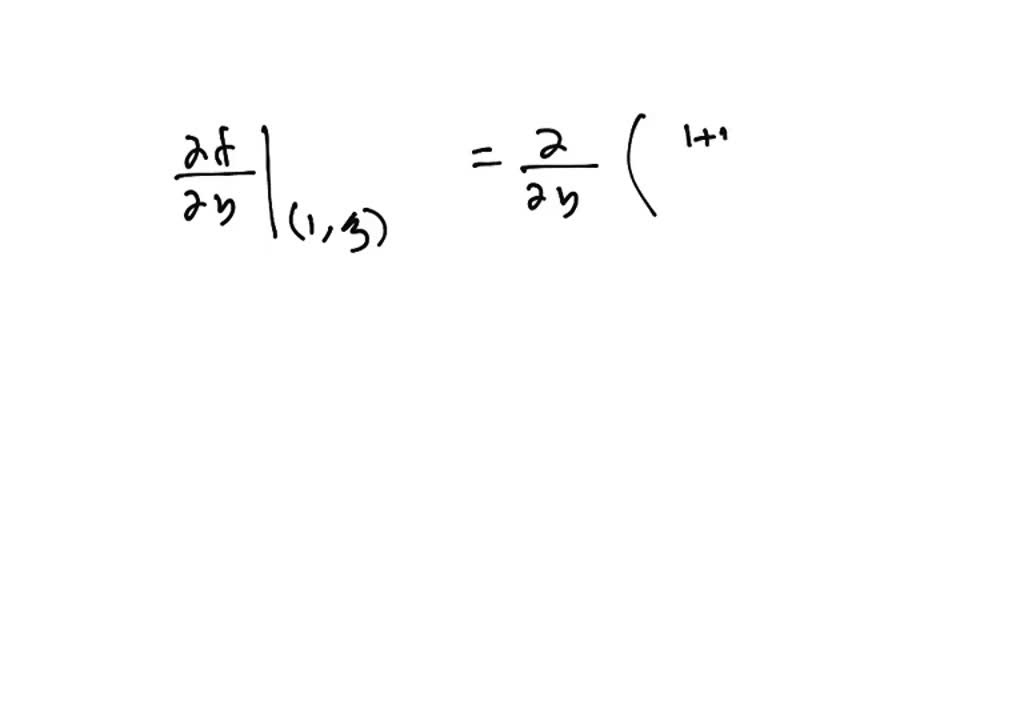Both Fx and Fy Are Continuous Functions for Xy 10 and F is Differentiable at 2 5

Explain why the function is differentlable at the given point, (x,Y) = 1 x In(xy (2, 3) The partial derivatives are fx(x, Y) and fylx, Y) = so fx(2, 3) = and f(2, 3) = Both fx and fy are continuous functions for xy and f is differentiable at (2, 3). Find the Iinearization L(X, Y) of f(x, Y) at (2, 3). L(x, Y)

Related Question
Explain why the function is differentiable at the given point. Then find the linearization $ L(x, y) $ of the function at that point. $ f(x, y) = \dfrac{1 + y}{1 + x} $, $ (1, 3) $
Discussion
You must be signed in to discuss.
Video Transcript
to begin the problem. Let's recall what different she abilities so recalled. Different. She ability see local property. So it means that, but the difference Stability at X comma y just depends upon how the function behaves on a Never heard of that point X come away. So I have the function f of X comma boy, is he going to one plus y divided by one plus six. The point is one common three. The if is well defined and different Schubel at in a volatile one common tree. So we have to find a neighborhood off one common tree so we can simply take the neighborhood zero comma, too, then cross with too common for so absurd. One comma tree belongs to this neighborhood. Zero comma too cross to come over for Okay, so no. So we have to find the partial derivative. So let's find the partial derivative tilt after all, Text at one common tree. It's going to be Delta off one plus why divided by one plus six, then delta off Delta X. So I have to treat my wires a constant. So that's why I put it in the parenthesis. So this is going to be negative one plus why divided by one plus X hold square and I have to evaluate it at one comma. Three. So X is equal to one. And why is it called the three So negative? Four. Divided by so one plus one is 22 squared. It's four so negative. Want salutes? Compute Delta Delta Bi. I've told by at one comma three, because that's the point we're interested in. So this is going to be dealt off kilter by off one plus why divided by one plus X at one comma tree again Now have to treat excessive construct. So this is going to be simply one devoted by one plus x at one comma. Three. So one divided by one plus one. So it's a gold toe half. So that's my Delta Delta y on DDE. What It's my if off X comma. Why at one comma? Three. So this is going to be one plus three divided by one plus one. So four divided by two. Is it going to? So next? Let's find that linear ization. So the linear realization off if it's recalled, this is if off x comma y plus tell tough del techs at X comma y times x minus X plus until Dr Delta y at X comma y times y minus way So we have X comma wise called to one common tree So the linear ization is going to be so what is What was my life off? One common tree If off one come on trees too So this is going to be too plus until type deal takes at one common tree Waas let me go back So that was negative one. So this is going to be negative one times X minus swan plus until after Tobi waas Tough so half ex Excuse me. So this is going to be why? Why Industry salutes me just right. Only the bitter form So too minus explain a swan. Let's half off. White minus three So two minor sex plus phone plus half off. Why minus to you over too. So it is 33 over two minus X plus half off way. Okay, so that's a solution
Source: https://www.numerade.com/ask/question/explain-why-the-function-is-differentlable-at-the-given-point-xy-1-x-inxy-2-3-the-partial-derivatives-are-fxx-y-and-fylx-y-so-fx2-3-and-f2-3-both-fx-and-fy-are-continuous-functions-for-xy-an-69706/

0 Response to "Both Fx and Fy Are Continuous Functions for Xy 10 and F is Differentiable at 2 5"
Post a Comment